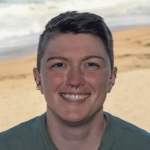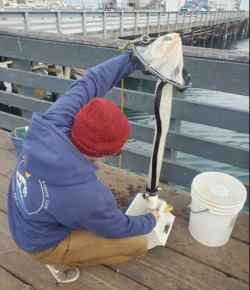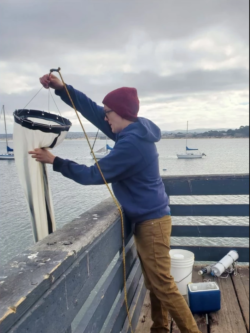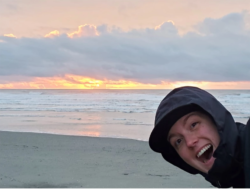
Pride In The Ocean: Q&A with Lyndsey Claassen

Written by Lyndsey Claassen (They/Them); Logistics Intern at the Monterey Bay Aquarium Research Institute (MBARI) and Master’s student at Moss Landing Marine Laboratories
How is your work connected to national marine sanctuaries?

Photo credit: Lyndsey Claassen
My thesis work uses Autonomous Underwater Vehicle (AUV) data in collaboration with the Monterey Bay Aquarium Research Institute (MBARI) to explore phytoplankton community structure across the Monterey Bay upwelling shadow. This shadow forms in response to active upwelling forces, and is a known incubator and retention center for Harmful Algal Blooms (HABs). The dataset I’m exploring is focused right in the middle of Monterey Bay National Marine Sanctuary.

Photo credit: Lyndsey Claassen
I’m hoping to explore covariances between taxonomy and eDNA of plankton to parameters in upwelled water parcels such as temperature and salinity, which could help inform bloom forecasting models. Because HABs fall within the primary producer category of our marine ecosystem, they impact the entire food web as toxins are bioaccumulated within organisms’ tissues. Marine birds, fish, and mammals are either killed or poisoned once they’ve consumed affected organisms.
What/who inspired you to pursue a career in ocean conservation?
An Estuarine Field Study course during my undergraduate career at the University of Washington, Tacoma was the culprit. We’d spend our Fridays going out on small boats and conducting what one professor called ‘puddle oceanography’. Hand hauling a CTD, dropping a Secchi disk over, and collecting all kinds of samples in water that was rarely deeper than 200 meters. We’d then practice our lab skills, one of which was phytoplankton identification and enumeration – a decidedly tedious process, but one I fell in love with at first sight. There’s something magical about peering through the eyepieces of a scope and realizing a tiny world is in each drop. I worked in the lab under the same professors once finishing the course, counting backlogs of Alexandrium, a dinoflagellate that creates toxins responsible for paralytic shellfish poisoning, and I’ve been eagerly learning about plankton and HABs ever since.
Phytoplankton are an incredibly important part of marine ecosystems that are often overlooked. What inspired you to create the @eucampia.serious Instagram account to highlight these charismatic microfauna? What is the most surprising thing you’ve seen under your microscope when studying phytoplankton?
The first job I landed after undergrad was with SoundToxins through Washington SeaGrant. This program pulled together a variety of groups who would collect a plankton sample once a week to monitor their location for HABs. As the Program Coordinator, I was responsible for creating reports and one of my all-time favorite tasks: teaching people about plankton. Anytime there was a new group, I’d go demonstrate all our protocols and basic phytoplankton taxonomy. Though I don’t have that role anymore, I’m still constantly sharing knowledge and pictures of plankton every chance I get (even when my grad school peers’ eyes start to glaze over). During quarantine I thought it would be fun to share general scientific knowledge and projects through Instagram, and the plankton part kind of took off from there. I find that I’m often doing research for some of the posts, and it’s been quite fun! The most surprising thing was remembering that some plankton hunt – I recently shared a video I found of a dinoflagellate using a spear like object to attack and tow away its prey!
In June we celebrate both Pride Month and Ocean Month. What inspires you to have pride in the ocean?
I find the ocean’s connectedness and power inspiring. While studying the core oceanography courses in grad school (i.e. physical, geological, chemical, biological), I realized they all bled into each other. Of course, I found a way to talk about plankton blooms in every single class, but it’s because of the ocean that physically brings up the nutrients. Its chemistry defines a species’ preferred conditions, and its geology records the blooms as they senesce and fall to become its bathymetry. Incredible waves mix and move water all around the earth in an endlessly circulating pattern that we have yet to fully understand.
What has your experience in the field of ocean conservation been like as part of the LGBTQ+ community? What actions can the ocean conservation community take to be more inclusive?

Photo credit: Lyndsey Claassen
As part of the LGBTQ+ community, I’ve felt quite welcome in the spaces I’ve occupied for ocean conservation. Seeing other queer people and having queer mentors was super helpful in that regard but having allies within the conservation community is awesome as well. These two aspects typically don’t occur in isolated incidents – I know I’m in a safe space that has allies when I see that other LGBTQ+ folks in the workspaces are welcome. Being respected as a person and how one identifies is one of the most inclusive things the ocean conservation community can do. A lot of organizations are including pronouns in their materials, which is a really easy way to signal to people that all are welcome.
What is your favorite memory at a national marine sanctuary or in the ocean?
While freediving with my partner we once accidentally found a sleeping octopus inside a giant shell. It was awesome and surreal, though it also 100% tricked me into believing I’ll see an octopus way more often than I have since. Also, this is probably going to be super cliché, but I recently got dive certified and it was AMAZING. I’m thrilled to continue exploring the alien world under the waves.
